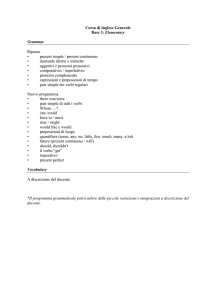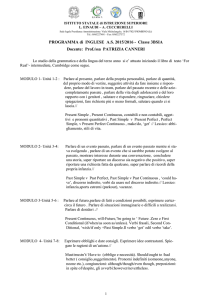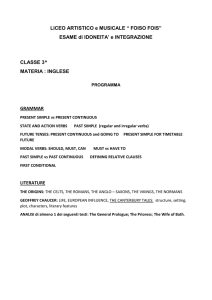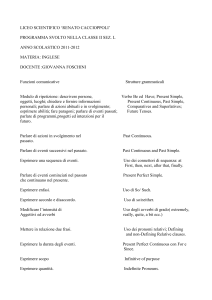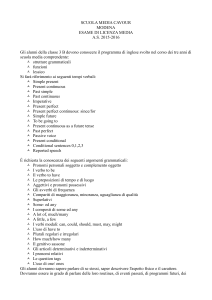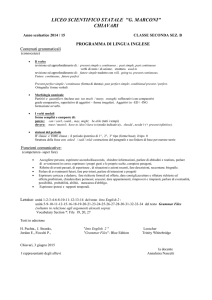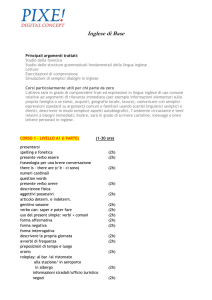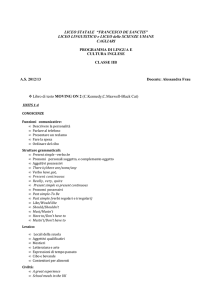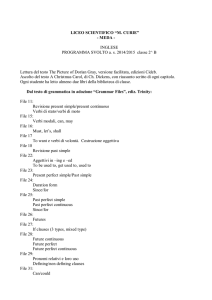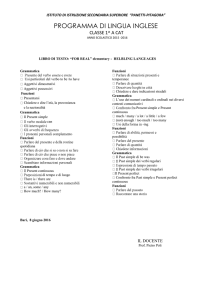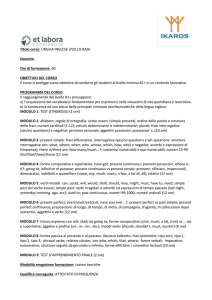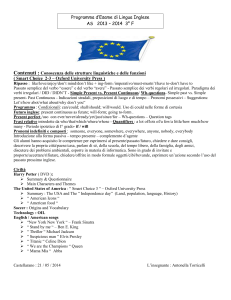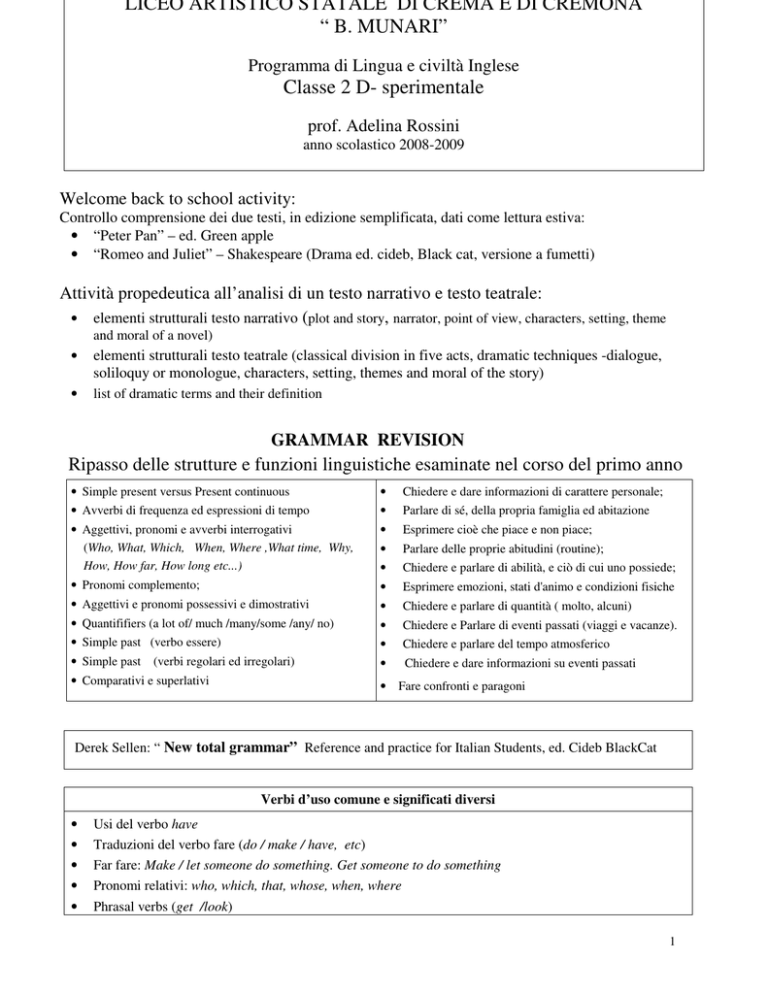
LICEO ARTISTICO STATALE DI CREMA E DI CREMONA
“ B. MUNARI”
Programma di Lingua e civiltà Inglese
Classe 2 D- sperimentale
prof. Adelina Rossini
anno scolastico 2008-2009
Welcome back to school activity:
Controllo comprensione dei due testi, in edizione semplificata, dati come lettura estiva:
• “Peter Pan” – ed. Green apple
• “Romeo and Juliet” – Shakespeare (Drama ed. cideb, Black cat, versione a fumetti)
Attività propedeutica all’analisi di un testo narrativo e testo teatrale:
• elementi strutturali testo narrativo (plot and story, narrator, point of view, characters, setting, theme
and moral of a novel)
•
elementi strutturali testo teatrale (classical division in five acts, dramatic techniques -dialogue,
soliloquy or monologue, characters, setting, themes and moral of the story)
•
list of dramatic terms and their definition
GRAMMAR REVISION
Ripasso delle strutture e funzioni linguistiche esaminate nel corso del primo anno
• Simple present versus Present continuous
•
Chiedere e dare informazioni di carattere personale;
• Avverbi di frequenza ed espressioni di tempo
•
Parlare di sé, della propria famiglia ed abitazione
• Aggettivi, pronomi e avverbi interrogativi
(Who, What, Which, When, Where ,What time, Why,
How, How far, How long etc...)
•
Esprimere cioè che piace e non piace;
•
Parlare delle proprie abitudini (routine);
•
Chiedere e parlare di abilità, e ciò di cui uno possiede;
• Pronomi complemento;
•
Esprimere emozioni, stati d'
animo e condizioni fisiche
• Aggettivi e pronomi possessivi e dimostrativi
•
Chiedere e parlare di quantità ( molto, alcuni)
• Quantififiers (a lot of/ much /many/some /any/ no)
•
Chiedere e Parlare di eventi passati (viaggi e vacanze).
• Simple past (verbo essere)
•
Chiedere e parlare del tempo atmosferico
• Simple past
•
Chiedere e dare informazioni su eventi passati
(verbi regolari ed irregolari)
• Comparativi e superlativi
• Fare confronti e paragoni
Derek Sellen: “ New total grammar” Reference and practice for Italian Students, ed. Cideb BlackCat
Verbi d’uso comune e significati diversi
•
•
•
•
•
Usi del verbo have
Traduzioni del verbo fare (do / make / have, etc)
Far fare: Make / let someone do something. Get someone to do something
Pronomi relativi: who, which, that, whose, when, where
Phrasal verbs (get /look)
1
MODULE 1: THE PAST
Il Past Simple (1) be e verbi regolari
Il Past Simple (2) verbi irregolari, have
Narrating events
Talking about past holidya
Past continuous
Past continuous versus past simple
Modal verbs-could & can
could for permission & requests
Actions in progress in the past
Polite requests
Traduzione dell’imperfetto italiano.
Used to ( e would)
riepilogo - revision
MODULE 2: THE PAST AND THE PRESENT
Il Present Perfect Simple (have + participio passato)
Il Present Perfect Simple e il Past Simple
Present perfect + yet, already, just, still vs
yet
have been vs have gone
Il Present Perfect Continuous e Simple + for / since/ How long? Talking about past experiences
Talking about recent events
For and since
Talking about experiences
Past Perfect Simple and Past Perfect Continuous
riepilogo- revision
Module 3: The Future
Il futuro con to be going to
Future plans and intentions
Il futuro con will
Talking about the future
Il futuro con to be going to o will: confronto
Offer/promise/instant decision vs plans
Future arrangement con il present continuous
Il futuro nelle frasi condizionali (di 1° tipo) e temporali
Future continuous: will be + ing form
/ when / as soon as/ if + simple present
riepilogo -revision
CLIIL (Content and Language Integrated Learning): ARCHITECTURE
•
Romanesque architecture in Europe (reading comprehension, analysis of major works and glossary)
N.B.
•
Quanto elencato sopra è stato ripreso ed esercitato anche con traduzioni e compilazioni di dialoghi e
telefonate al fine di utilizzare i tempi esaminati anche in situazioni comunicative.
•
A tale proposito si è ripassato ed ampliato il lessico relativo a: invitare, fare proposte, esprimere parere,
commentare ed è stato compilato un breve elenco dei più diffusi conversation fillers ( a proposito,
davvero? Non fa nulla etc.)
Sono state inoltre fornite tabelle sommative- riassuntive per quanto riguarda use & usage di tutti i tempi
passati esaminati ed i tempi futuri (present continuous con valore di futuro, going to future, will future ).
L’Insegnante
…………………………………
I rappresentanti di classe
……………………………….
……………………………….
Crema, …………………………
2

